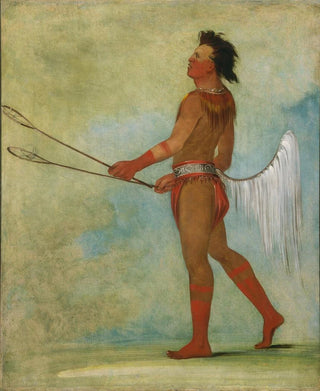Art print | TulLockChshKo squeezes the juice from the stone dressed as a ball player - George Catlin


View from behind

Frame (optional)
In the fascinating world of art, some works manage to transcend their era and capture the very essence of a culture. The TulLockChshKo art print of a boy drinking from a stone, dressed as a ball player - George Catlin is a perfect example. This piece, which evokes the rituals and traditions of Indigenous peoples of America, immerses us in a world where art and spirituality meet. Catlin, as an attentive and respectful observer, offers us a window into a rich and complex past, while emphasizing the importance of cultural practices that continue to influence current generations.
Style and uniqueness of the work
George Catlin's style is characterized by a realistic approach and meticulous attention to detail that define his representations of Native peoples. In the TulLockChshKo art print of a boy drinking from a stone, dressed as a ball player, Catlin manages to capture not only the physical appearance of his subject but also the spirit of the scene. The vivid colors and carefully rendered textures testify to his undeniable talent as a painter. Every brushstroke seems to tell a story, every shade of color evokes an emotion. The posture of the central character, both majestic and humble, reflects the harmony between man and nature, a recurring theme in Catlin's work. This uniqueness makes this piece a centerpiece that captures the eye and the mind, inviting the viewer to contemplate and reflect.
The artist and his influence
George Catlin, 19th-century artist and ethnographer, dedicated a large part of his life to documenting Indigenous cultures before they disappeared under the effects of colonization. His work is not only artistic but also historical, offering valuable documentation on the lifestyles, customs, and beliefs of the peoples he encountered. Catlin was one of the first to understand the importance of preserving these cultures through art, and his influence endures to this day. His paintings are now considered cultural treasures, allowing future generations to understand

Matte finish

View from behind

Frame (optional)
In the fascinating world of art, some works manage to transcend their era and capture the very essence of a culture. The TulLockChshKo art print of a boy drinking from a stone, dressed as a ball player - George Catlin is a perfect example. This piece, which evokes the rituals and traditions of Indigenous peoples of America, immerses us in a world where art and spirituality meet. Catlin, as an attentive and respectful observer, offers us a window into a rich and complex past, while emphasizing the importance of cultural practices that continue to influence current generations.
Style and uniqueness of the work
George Catlin's style is characterized by a realistic approach and meticulous attention to detail that define his representations of Native peoples. In the TulLockChshKo art print of a boy drinking from a stone, dressed as a ball player, Catlin manages to capture not only the physical appearance of his subject but also the spirit of the scene. The vivid colors and carefully rendered textures testify to his undeniable talent as a painter. Every brushstroke seems to tell a story, every shade of color evokes an emotion. The posture of the central character, both majestic and humble, reflects the harmony between man and nature, a recurring theme in Catlin's work. This uniqueness makes this piece a centerpiece that captures the eye and the mind, inviting the viewer to contemplate and reflect.
The artist and his influence
George Catlin, 19th-century artist and ethnographer, dedicated a large part of his life to documenting Indigenous cultures before they disappeared under the effects of colonization. His work is not only artistic but also historical, offering valuable documentation on the lifestyles, customs, and beliefs of the peoples he encountered. Catlin was one of the first to understand the importance of preserving these cultures through art, and his influence endures to this day. His paintings are now considered cultural treasures, allowing future generations to understand






